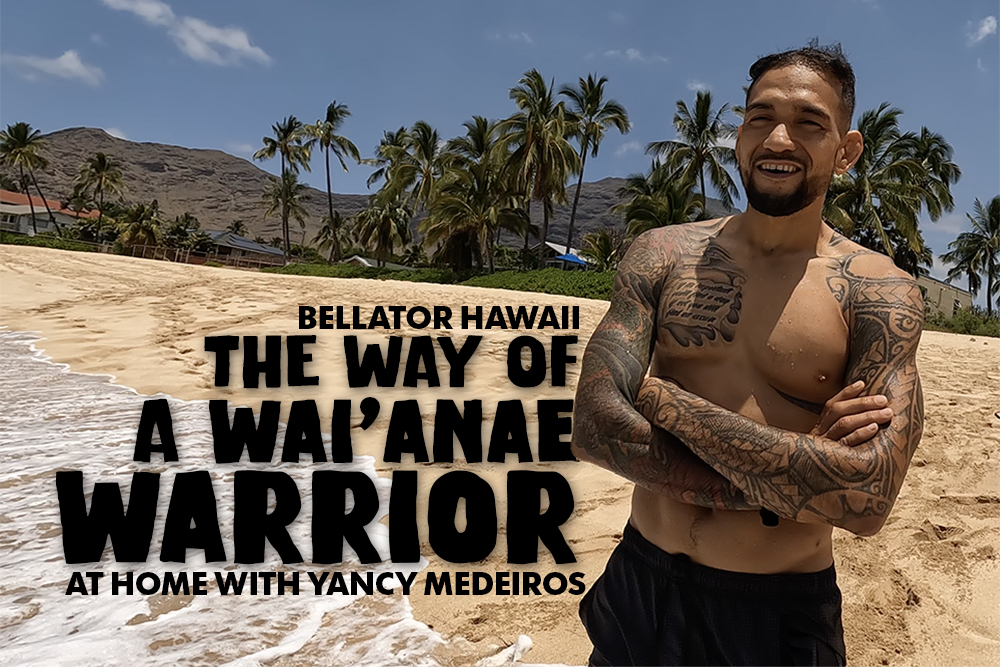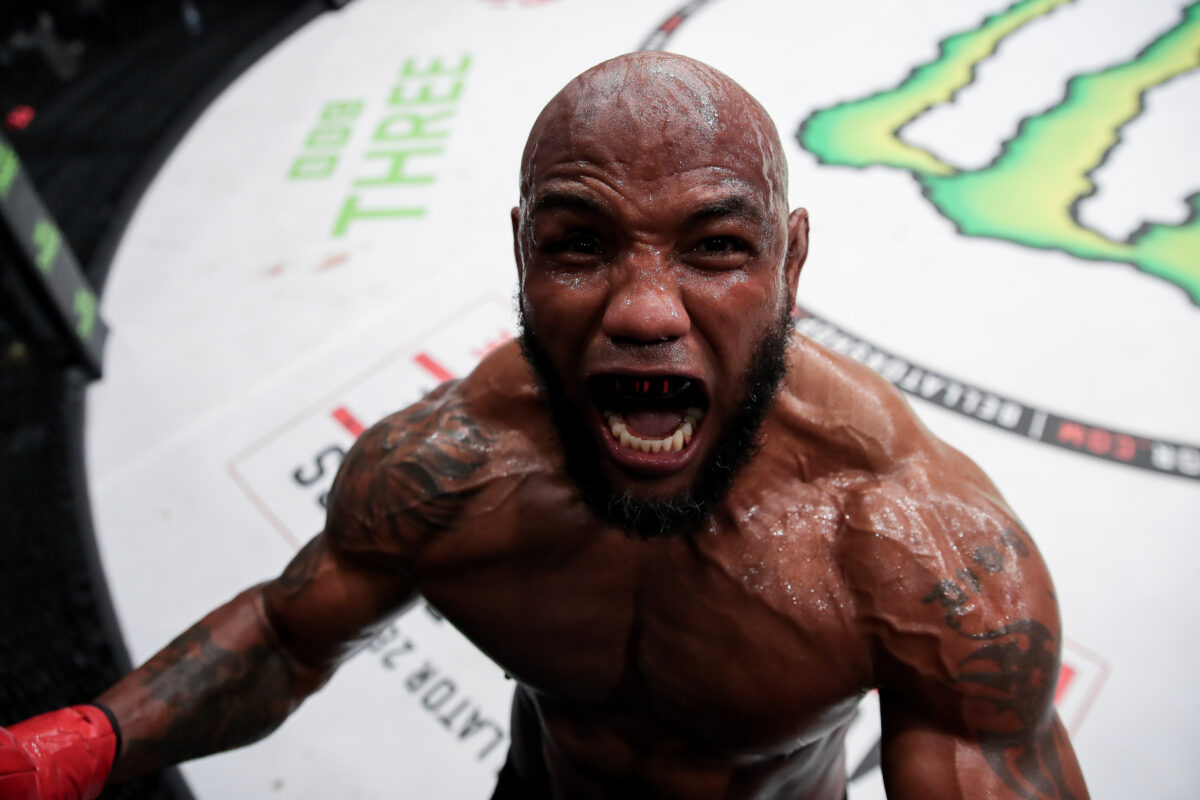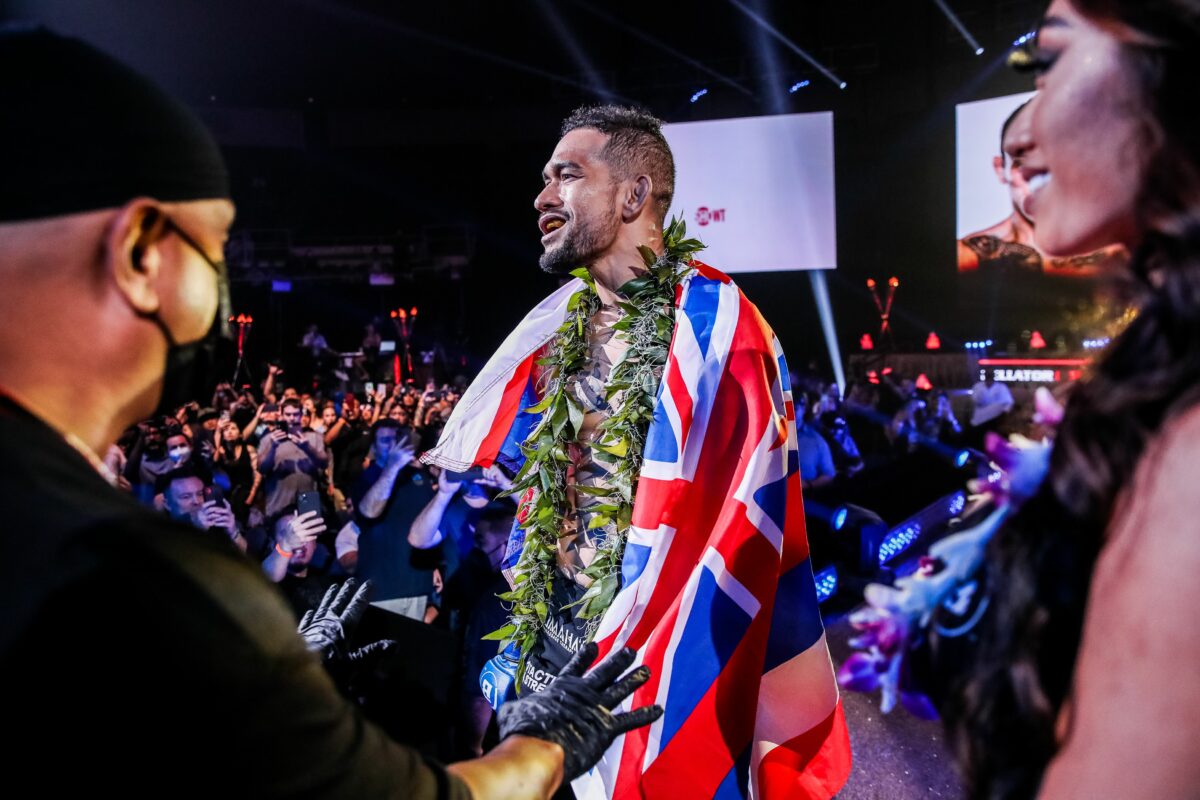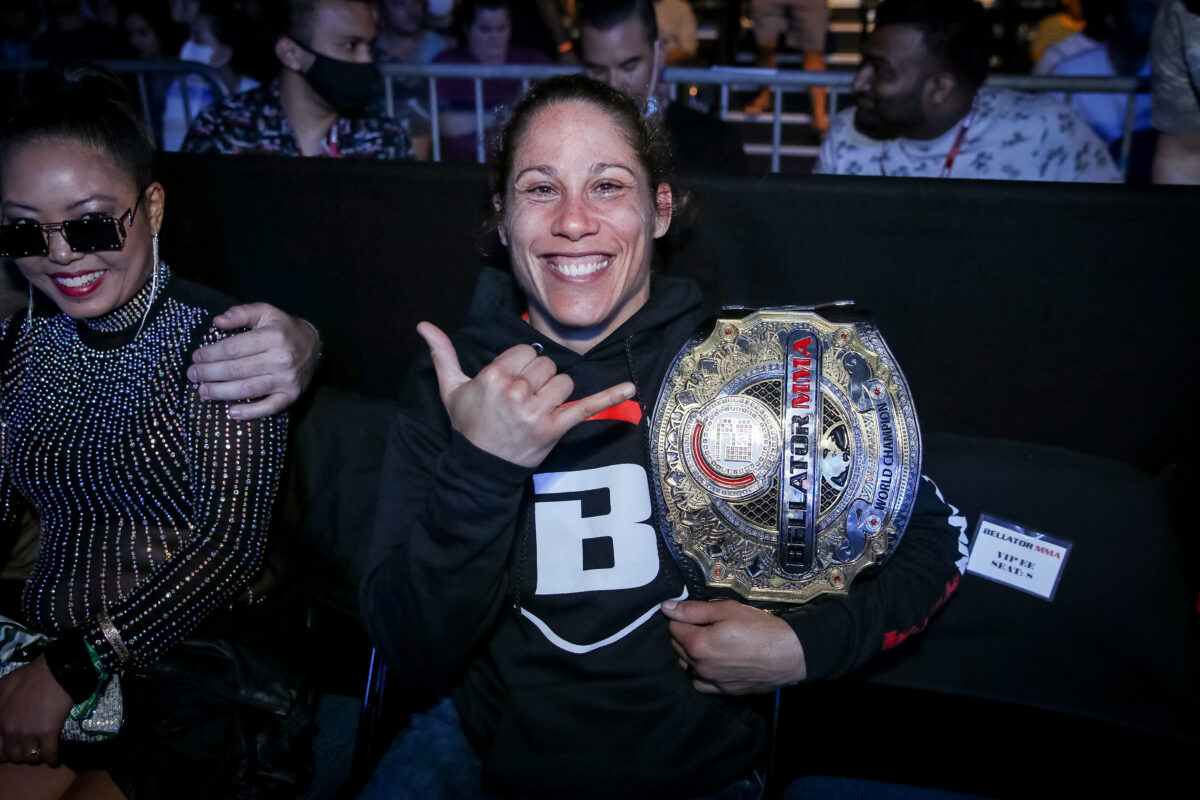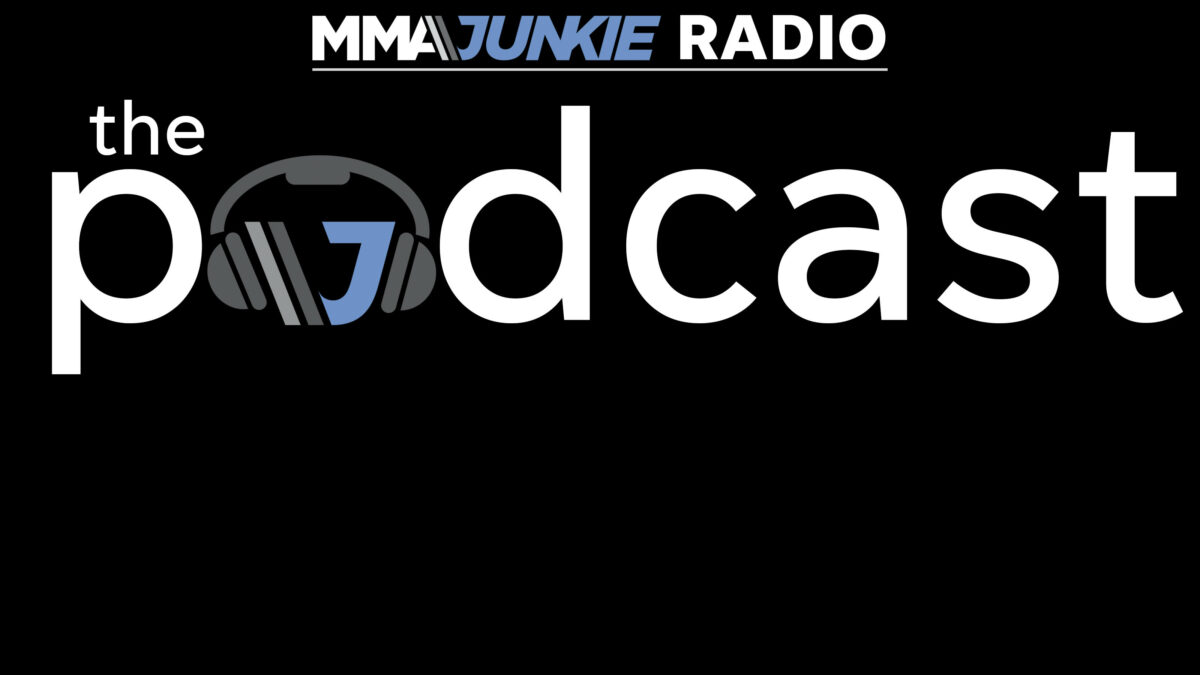WAI’ANAE, Hawaii – “Was that it?” I asked, as our rental car drove past the pegged spot on the GPS.
We pulled up on the curb around the backside of the building and received a shaka from an oncoming black truck. We paused to let it pass and bang a uey.
We were back staring at the outside of the building through the windows.
That’s when we saw the arrow. It was unassumingly small and blue, pointed diagonally left-upward with white letters, “DOJO.” If you weren’t looking for it, you would miss it. Heck, we looked for it and still missed it.
The outside of the building resembled more of a vehicle fix-em-up shop than an MMA gym. Men cleaned a car outside as we approached. The breeze blew the ferns outside the chain-linked fence that surrounded a “BOB” dummy and other training apparatuses. It was the final clue we were in the right place.
It was not a typical MMA gym, that’s for sure – but boy, was it tranquil.
We pulled into the dirt lot alongside a few other cars, got out, and strolled up to the blue arrow. Two men were standing under it. They greeted us with big smiles. We shook hands and introduced ourselves. They knew we were coming.
“Yancy will be here in a few minutes,” the older of the two men said with a smile.
Our only interaction with [autotag]Yancy Medeiros[/autotag] before all this was a few run-of-the-mill media day happenings. But you wouldn’t know that.
Our trip across Oahu from Waikiki Beach to Wai’anae stemmed from a text I sent when we landed on the island saying something along the lines of, “Hey, we’d like to come interview you at your gym.” I quickly received a response, ‘Bet. Will make it Hawaiian AF lol …'”
What stuck out the most was what was sent a few texts later – a message that was a small sample of the hospitality and aloha that was incoming.
“Would’ve did (this) for you guys even if you weren’t working. aloha. Welcome to Hawaii brotha.”
It was foreshadowing of the perpetual and innate hospitality we were in for.
Right on cue, a minute later, Medeiros strolled up, smiled, and gave the half-handshake, half-hug. He wasn’t alone. A four-legged companion we quickly came to know as Kardi B came to say her hellos, too.

Uncle Mike
The younger of the two men outside parted ways as he returned to internal cleaning the car. The elder man, identified by Yancy as “Uncle Mike,” led the way up the black staircase from the backyard to the second floor. With a shaved head and a long gray-black beard with a white stripe down the middle, Mike Talalotu, come to find out, is a staple in the Hawaiian MMA community.
As we strolled up the stairs, a large black banner greeted our eyes. “YANCY MEDEIROS” and “MAKI PITOLO” were printed on the Westside Striking banner. Each fighter’s personal phone numbers was listed beneath the letterings, in case any neighborhood kids needed their contacts.
As we made a turn up the final few stairs, an annex-like workout room was visible. Mats. Hanging heavy bags. Medicine and yoga balls. A bike. A small bathroom. A grappling dummy. The necessities. Character.
A quick peek around showed something else: history.
The humble facility was proud, an unofficial museum for Hawaii combat sports. Posters lined the highest point of the wall where it connected with the ceiling. They flowed with a gentle breeze that was not strong enough to blow them off, but persistent enough some would likely remain in the same angled position if the wind stopped blowing. A stack of trophies covered in a thin layer of dust were piled on a desk in the corner.
As two Hawaiians put in work, the room became increasingly hot and sticky. Outside the windows, the hills rolled tall, not your average MMA gym surroundings.
For about an hour, Medeiros and Uncle Mike did their routine. Even when visibly drained, Medeiros perked himself up with a smile and a few nods, almost as if he was listening to a cheerful song in his head – positivity radiant.
As we came to find out from Medeiros, Uncle Mike rents the room out from “Uncle Doug,” not with the sole focus of world-class fighters, no. The purpose is to serve the community – through its youth.
Despite his unassuming demeanor, Mike was a killer kickboxer back in the day, and you can even find some preserved VHS-to-YouTube transferred videos on the internet. A practitioner of combat sports since age 10, Mike witnessed the rise of MMA in Hawaii first-hand.
Now, Mike provides children in the Wai’anae and Makaha area an alternative to trouble. He runs classes for kids powered not by their financial status, but by how good of a person and student they are. It’s not about the money.
There’s trust all around. Uncle Mike and Medeiros aren’t bound to earnings percentage shares by contracts. An unspoken dedication and understanding of aloha is enough of a guarantee.
“It’s all by word,” Medeiros later told me. “I don’t know what families you guys have, but I have a family here. Our words and our actions mean everything, not a piece of paper and a pen. I think that’s very, very tribal and family-like to have. It’s more than just love. It’s understanding and acceptance. Everybody that I deal with in my martial arts journey is a family. I treat them like that.”

The embodiment of aloha
“aloha” is perhaps the most well-recognized Hawaiian word, but it’s more than just a greeting, I came to learn. Every time Medeiros used it, the meaning was slightly different, but it always represented the most positive thing in the sentence: a feeling, an attitude, a lifestyle, a gift.
“I want to let everyone know that we’re all the same,” Medeiros explained. “My culture and my surroundings, it empowers me to do that. I’m like, ‘Nah, brah. We’re all the same. We’re all one. When I win, you win.’ If you don’t like me, you don’t need to like me. But you’re going to know I’m a good guy and you can keep your distance.”
The practice finished with pools of sweat everywhere. Kardi B rose from her obedient resting spot to resume her own sparring: against the big, red yoga ball. It was a 10-8 for Kardi, though the ball snuck in a haymaker as it ricocheted off the wall.
Uncle Mike thanked us for coming and departed. Medeiros dried himself off a bit, then cleaned the mats. He pulled up a chair and the chit-chat began.

The rawness of it all
The Wai’anae-Makaha area on the “West Side” of Oahu had its fair share of troubles for a young Medeiros. While it may seem like Medeiros defied the odds, chat with him for a few minutes and learn how his straight-edge journey toward MMA stardom makes all the sense in the world.
From a young age, Medeiros focused on positivity. Negative influences, attempts at peer pressure, and drugs were all things in front of him – but they never deterred him from his road. They made him wiser and more authentic.
“I grew up with the rawness of it,” Medeiros said. “On my street were drug dealers, gang members, all that. But it was tribe-like and family. There was no judgement. Put it this way, bro. I was five. For five years of my life, I didn’t know my grandma. My grandparents were homeless and did ice. But every weekend, we’d go to grandma’s house, which was at the beach. She had a little shack.
“Growing up and having these experiences, I knew there were hardships. Life is unfair. We have all these things, but love and aloha just kills it all. You can still be happy. That’s why I can never judge people, because I’ve seen what unfortunate choices and mistakes make for people and my loved ones. I’m like, ‘Brah, who am I to judge anyone when I can love like that for people of my own?'”
Medeiros qualifies in the top fraction of a percentage of alphas on planet earth, but he doesn’t fit the stereotype. He’s never been in a street fight, despite his longest ongoing relationship being martial arts. The streets have never been his proving grounds.
When others weren’t secure enough to throw on a wrestling singlet, Medeiros was. To Medeiros, that was alpha. So yeah, it’s a bit ironic he’s a fighter. Medeiros laughs about it, like he does most things.
“Not be different, but be me,” Medeiros said. “It wasn’t going to be dictated by peer pressure. I was always just doing my thing. In high school, nobody thought I was going to fight, because I was just like this. I never had a street fight, bro. My last fight was in like elementary. That’s not even a fight. That’s a scuffle. Ironically, I want to be peaceful and joyful but I like punching people in the face, too. It’s an ironic career but I love it.”
That attitude is why Medeiros is part of one of the tighest-knit units in all of combat sports, an exclusive brotherhood that chooses you – you don’t choose it.

Palalas
Shortly after a Strikeforce fight in 2010, Medeiros was chosen, by then-already-established [autotag]Nick Diaz[/autotag] and coach Cesar Gracie. Twelve years later, he’s a staple of the Army.
“I was fighting this jiu-jitsu dude they didn’t care for,” Medeiros said. “I believe Nick grappled him a couple times. … Cesar Gracie jiu-jitsu, bro. Everything they do, that’s going to be in a street fight, too. They’re not going to be the sport jiu-jitsu. It’s not their thing. They’re real life. … They seen me fight and after the fight, they’re like, ‘Bro, want to come train?’
“Cesar Gracie called (matchmaker) Rich Chou to bring me over from the back. Cesar Gracie is like, ‘You want to come train with us? Come through. Come train.’ That’s how it started. Ever since then, Nick is the general. Nate is the Palala, my brother.”
The bonds between the Diazs and Medeiros are strong today. But initially, Medeiros didn’t know what to expect. Public misconceptions of the Diazs made him nervous for his first trip to Stockton, Calif. to work with them.
“I only seen what the media portrayed, but I’m all about connecting,” Medeiros said. “I’m like, ‘Bro, these guys are cool.’ When I went home, I was like, ‘The last thing I’m going to do is get punked, so I might be fighting up there. I ain’t no bitch.’ But they ain’t punks. Nick and Nate ain’t punks.
“They’re just real individuals. If you’re looking at them weird, they’re going to be like, ‘Why are you looking at me weird?’ They’re real. If you’re a good guy, you’re a good guy.”
Realness. Chillness. Modesty. Healthiness. Loyalty. Of course, marijuana, too. The relationship isn’t simple math, but the personalities actually align parallel. A life-changing compliment to Medeiros, the Diaz Brothers saw holes in his lifestyle he would never have found otherwise.
Without them, Medeiros probably wouldn’t be plant-based diet. He probably wouldn’t have run a triathlon. Heck, Medeiros wouldn’t have even taken full advantage of his own backyard.
After his training session, Medeiros took us to a spot on the beach. It’s been his spot since – well, forever. It was about a four-minute drive from the gym, and a minute away from the house he grew up in.
Hundreds of times he’s hit sand and water to chill, take a dip, or hang out with some friends. But one time, when Nate Diaz came to town to visit, he changed not only Medeiros’ perspective on local geography, but the lens through which he views life entirely.
A small hill splits Medeiros’ beach of choice. It’d always been there blending into the background. But for Nate Diaz, it was on the foreground.
“Have you ever been up there?” Diaz asked Medeiros years ago.
Yancy thought for a moment. Nope.
“Why not?” Diaz asked.
Medeiros didn’t have an answer, so they went up there.
It was the first time for Medeiros, but not the last. That intuition is the same Diaz open-mindedness that led Medeiros to jogs in Stockton, to impromptu marathons, and beyond.
Nonjudgemental surroundings led to Medeiros’ self-discovery. It still sticks out to him during his first triathlon how bad he was doing yet how excited Nick Diaz was when he finished.
“I had to earn my relationship. Not earn it, but earn my ranks, pay my dues,” Medeiros said. “If you can pay your dues, you’re a soldier and roll with the crew. That’s what I did. I went up there every time. All the tests they put me through, I did it, because I’m like, ‘I ain’t no b*tch.’ That was my constant.
“Nick totally tricked me into doing a triathlon. I never trained for that sh*t. I did it though, in Lake Tahoe. I ain’t no b*tch. The first time I did it, it took forever, but I still did it. They made me a better martial artist, a better human being. They made me just live life. Whatever you want to do, do it and experience and embrace it.
“As soon as I finished that triathlon, Nick was watching me. He was f*cking so excited for me: ‘Nobody is f*cking doing that right now.’ He looks me in the eye, ‘No f*cking fighter is doing that right now, bro.’ This is like in 2013. I’m like, ‘Yup. You’re f*cking right.’ It was so empowering because it’s just live life, get tired, be uncomfortable. You’ve got to love it so much you hate it. That’s what it was, bro. But I was able to perpetuate my attitude, my culture, and my aloha with all that.”

In 2018, Medeiros adopted another Diazism: plant-based dieting. He doesn’t want to put himself in the boxed absolutistic construct of veganism, so thus the differentiation.
“We’re emotional creatures, bro,” Medeiros said. “We feed off emotions. Happy, sad, mad, stressed. When you can control your emotions, you can control what you eat. You can dictate a lot of things in your life, especially the joy and madness that comes with it.”
Happier and healthier than ever, Medeiros implemented a plant-based regiment not only for himself, but his daughter Kaya as well.
“When she’s 18, I can give her her keys to her car and she can drive life however she wants to,” Medeiros said. “That’s my belief on how I keep her optimal. You have two homes, but you have two report cards when it comes to my kids: your grades and your body. That’s that.
“Plants have made it accountable for me to keep a healthy lifestyle, not just with what I consume with my mouth but what I see and hear, also. It made me want to make healthier choices. I can consume all this toxicity and all this badness going on, but I know what I eat and consume in me makes me better. It’s simple for me to dictate life and be happy.”

“We grew up together”
One year before his professional MMA debut, Medeiros became a father. At 19, it was a massive commitment added to his budding fighting career. Through ups and the downs, a spark remained constant.
“We grew up together,” Medeiros said, with a smile, at Aloha Poke, a local food spot he took us to. “I’m still growing. When I was younger, I was always like, ‘I’ve got to fill these voids. I’ve got to teach her these things, but as I grew older and I got more into myself, I felt like a parent, it’s time to unlearn what you learned as a kid and learn with your kid, build a real relationship. Over the years, I did that. Me and her mom aren’t together, but (for) my daughter, it’s still so close. We’re still her parents. She still has family and she still has love. It’s definitely a big drive for me.”
Medeiros admits, Kaya isn’t really invested in his fighting. But that’s OK. Her happiness comes first and he knows she supports him, even if she’s watching a musical down the road from the arena he’s fighting in.
“She supports me,” Medeiros said. “But I don’t mind it, like, ‘Honey, you don’t like watching me fight? That’s OK.’ I’m her protector.”
“I’m going to tell you a funny story. One day, my daughter comes up to me and I can talk to her like she’s my best friend. I’m a parent but there are times where we break down. She’s like, ‘Dad, you know sometimes, when I was mad at you, I went on YouTube and I watched the fights you lost.’ And I was like, ‘What? I ain’t lose no fight, girl.’ She’s like, ‘Dad, I’ve seen the fights.’ I’m like rolling inside. Like, brah, ‘You guys fighting, don’t be losing no fights, kids, because your kids are going to be doing that to you.’ It’s like, ‘Really, girl?’ I can’t be losing any more fights now. I was just like, ‘Dammit.’ I didn’t know any way to take it but laugh. That’s hilarious, brah. … Don’t be losing no fights. My daughter will be watching that sh*t.”

A home game
It’s now three days after our visit. It’s the middle of the day, but fights are happening during the second leg of a two-night doubleheader at Neal S. Blaisdell Center in Honolulu. It’s Bellator 279. The arena is small and weathered, but filled to the brim with character.
With Uncle Mike and coach Ivan Flores by his side, Medeiros calmly struts into the venue. Despite all the prolific stops throughout his career, the meaningfulness of a Blaisdell battle was not lost. It was the original dream, the one he saw as most obtainable feat during his early MMA days.
And there he was. A 34-year-old kid. Yancy Medeiros, the guy who never angled for anything to be about him. The guy who always stayed true. For someone who would never be ruled by the court of outside opinions, it was apparent the love was abundant.
There is no one more popular than Yancy Medeiros in a room full of Hawaiians.
Like the Diazes, what Medeiros never sought, he found. Attention.
Laughing and joking with fellow islanders Keoni Diggs, Sumiko Inaba, and Ryan De La Cruz, Medeiros was unfazed when his fight was bumped from the featured prelim to the main card at the last second.
Whether it was an intentional bump or an accidental run-long of prelims, things couldn’t have turned out better for Medeiros. As the pre-fight promos played on television, the arena sat staring at a Bellator logo. The minutes ticked by the top of the hour.
Eventually, Medeiros emerged from the locker room. It was down some stairs, outside, past a rehearsal of Ilima-Lei Macfarlane’s traditional Hawaiian walkout, and into the lower bowl. As he paced, the crowd took notice. The love audibly rained down.
Rather than be “too cool” or “in the zone” Medeiros did what he always did. He embraced them, playing to them. The noise level built until it was finally time to walk and an Israel Kamakawiwo’ole mashup rang throughout the arena.
The fight against Emmanuel Sanchez fit the bill. The two lightweights went toe-to-toe for 15 minutes. At time Medeiros would play to the crowd, though not to disrespect Sanchez. The Palala Nate Diaz was front row.
Medeiros found his mojo and his mojo won him the fight via unanimous decision.
“I’m always going to promote this love and aloha, so come hire this kid,” Medeiros said after the fight.
All of the pieces fell into place just how Medeiros predicted.
He asked for a chance.
He said he’d win.
He said he’d earn a multifight deal.
All of that became reality.

While the paydays and accolades are cool, the earned opportunity with Bellator is about neither for Medeiros. It just means he has more time to do what he loves, what other people enjoy, and share that experience with them. Saturday, Medeiros reunites with his fans again when he fights Charlie Leary at Bellator 295.
If Medeiros embodies one thing, it’s aloha is not limited to an island border. Medeiros brings the radiant positivity with him everywhere he goes and tries to improve the world one aloha at a time.
The world could use a little aloha, after all.
Luckily, Yancy Medeiros is here to spread it for the entirety of his existence.
“My goal in life is to, I guess, be a kid,” Medeiros said. “What do kids do when they wake up? they just want to be happy, bro. You have responsibilities as a human you want to take care of. That’s what I want to do. I want to be able to take care of my responsibilities, be a kid, and serve people.”
“… There’s a lot of chaos and a lot of negativity – especially now. Having aloha is a practice everyday and it’s not easy. But it’s way easier than being mad. Forgiving and having aloha is way easier in this world, brah.
“Seriously, be happy – and have some aloha.”
